Rural housing: Options to decarbonise and improve efficiency
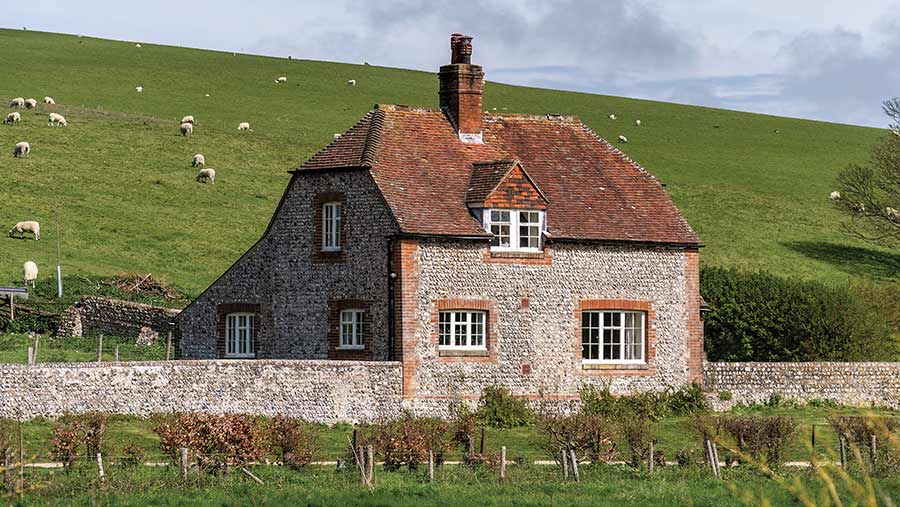 © Adobe Stock
© Adobe Stock From period farmhouses to farmworkers’ cottages, rural housing comes in many shapes and sizes, but they all share similar challenges when it comes to energy.
Rural properties off the mains gas grid often rely on boilers fuelled by domestic heating oil (kerosene) to supply heating and hot water, with LPG, log burners and open fires playing important roles too.
The construction of older properties can also sometimes be fairly basic when it comes to insulation and energy efficiency, although this problem is by no means limited to rural areas.
Times are changing, though. Renewable technology is developing rapidly, and there is strong political desire to decarbonise both the commercial and residential sectors, with financial help to do so [see “Support available”].
See also: Solar grants for farm projects what’s covered and how to apply
Recent years have brought extra financial impetus to improve energy efficiency too, not least following the energy price hikes in 2022, since when domestic heating oil, gas and electricity prices have remained stubbornly high.
Key messages
- Identify your energy objectives
- Think “fabric first” by improving the building’s energy efficiency first
- Identify potential sources of grant funding to assist with capital costs
- Consider suitable technology to decarbonise heating or power use
- Seek expert advice from specialist energy consultants
Have a clear aim
Saving on energy bills is understandably a key reason for wanting to improve energy efficiency, but it may not be the only one.
Michael Fountain of Savills says before making any changes to a building or heating system, it is important to step back and identify your main aim, which is usually one or a combination of three main factors:
- To reduce energy running costs of the property
- To improve the Energy Performance Certificate (EPC) rating – for example a landlord wanting to meet minimum or future EPC compliance criteria for a rented property
- To decarbonise energy usage and maximise the full potential of the property in terms of energy efficiency and energy generation to reduce overall carbon emissions.
Recognising the end goal is important, as this determines the type and scale of any improvements that will need to be made, he says.
Strutt & Parker’s Alexander Macfarlane agrees, adding that occupier comfort is another important consideration.
“There are a number of small interventions you can do to make a property more comfortable to live in that wouldn’t necessarily get picked up on an EPC, such as draught-proofing around doors and windows.
“Equally, there might be things you can do to improve the EPC score that don’t have a great impact on the comfort of those living there.”
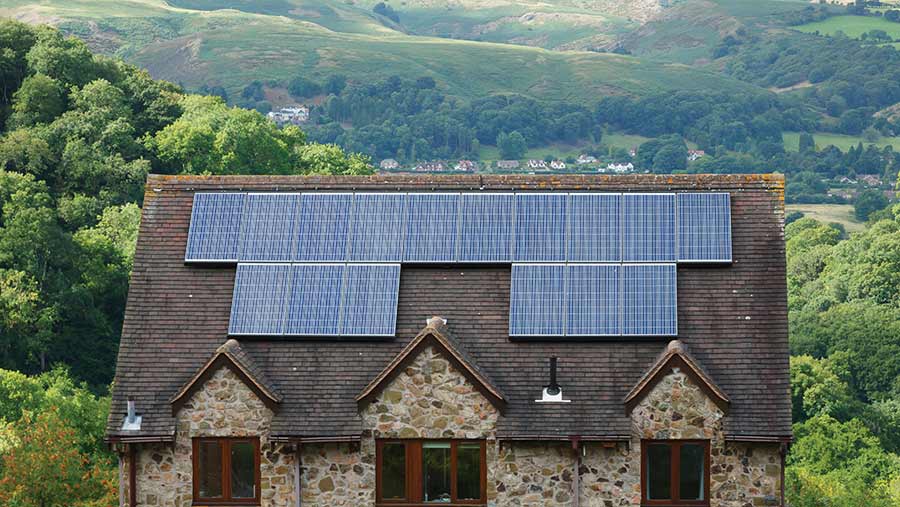
© Adobe Stock
Fabric first
Once the aims are clear, Michael says the next step is to assess the condition of the property and its occupancy.
“For example, if it’s an empty property that hasn’t been touched since the 1960s, it’s at a milestone where significant refurbishment may be required, which could be a good time to make big energy efficiency improvements to future-proof the property, if budget allows.
“Conversely, if the property has been well maintained, with a relatively efficient boiler, and is in a good state of repair, then it’s unlikely you’ll want to carry out large-scale, expensive upgrades for a few years, so you may look to smaller, less disruptive measures in the interim.”
Either way, he encourages people to think “fabric first” by identifying ways to improve the building’s energy efficiency, before considering the most appropriate alternatives to replace, or reduce reliance on, fossil fuel-based heating systems.
“If the fabric of the building has poor insulation and heat retention, it will greatly reduce the effectiveness of any new technology installed, such as a heat pump.
“Upgrades to the building’s fabric [insulation] can be simple or more complex measures, but they generally last many years, and benefit any system installed now or in the future.”
The main energy efficiency improvements to consider for any property are summarised in the panel “Improving energy efficiency – fabric first”.
Weighing up the options
Once all relevant steps have been taken to maximise energy efficiency, it is time to consider ways of replacing, or reducing the reliance on, fossil fuel-based systems.
To illustrate this, three example properties of varying size and character have been used, to identify the changes that might be implemented for each one, subject to budget and other considerations unique to individual circumstances.
These properties and upgrades are outlined below and summarised in the table “Summary options for three example properties”.
Property 1 – Small bungalow
This is a 60sq m bungalow built in the 1960s with standard brick construction, possibly with a cavity wall. It is currently reliant on LPG for hot water and traditional radiators, plus a small 5kW wood burner for secondary heating.
With a small floor space to heat, an air-source heat pump is potentially the best option for heating, says Alexander.
If the existing radiators are in good condition and can be used with the new system, the cost is likely to be around £10,000-£12,000, although a grant of up to £7,500 is available via the boiler upgrade scheme (see table “Support available”).
Larger, more complex systems could cost three or four times this to install.
The Energy Performance Validation Scheme (EVPS) requires suppliers of green energy products to meet certain standards, so is a good starting point when gathering quotes.
Standard air-source heat pumps run at lower temperatures than a traditional boiler – typically around 45C, rather than 75-80C – so the property needs to be well insulated to work effectively, Alexander says.
They are most effective for providing consistent background heating, rather than the instant “blast” of heat from a traditional boiler and radiator system.
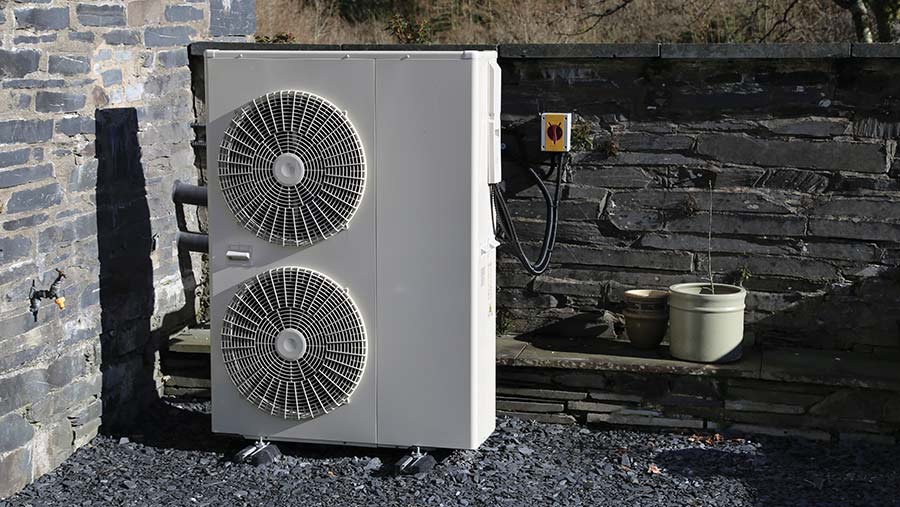
© Adobe Stock
Heat pumps often work best when connected to underfloor heating systems, although this will require additional work (and cost) and may not always be feasible for solid floors.
Where existing radiators are being used, Michael says that because the water circulates at a lower temperature, it may be necessary to install radiators with a larger surface area to improve their effectiveness at heating spaces.
Alexander also notes that running costs for air-source heat pumps are higher than for traditional boiler systems, as they require an electric pump to be running while the system is in use.
For a typical three-person household, he says running costs might be around £200 more a year for an air-source heat pump over a conventional boiler (based on prices at the time of writing).
Careful consideration should also be given to positioning of the external unit, which requires good airflow for optimum performance.
For the hot water supply, the output of a standard heat pump is likely to need topping up in some way.
This could be provided by retaining the LPG boiler, but this would mean losing the £7,500 air source heat pump government subsidy.
The simplest and cheapest option to accompany the heat pump would be an electric immersion heater in a hot water storage tank.
If the budget allows, an alternative is to heat the water by rooftop solar PV panels and battery storage.
Where this option is taken, Michael says a controller unit can be installed to automatically divert excess power before exporting to the grid. “Once any batteries are fully charged, it prioritises load within the property first, then heats the hot water.”
Property 2 – Semi-detached cottage
This is 120sq m, built in the early 1900s with standard brick construction, solid wall or basic cavity wall.
Also features suspended timber floors with air vents. Heating and hot water are currently provided by an oil-fired boiler, plus a 5kW wood burner.
An air-source heat pump is once again the main heating option, although with suspended floors, it may be more feasible to install an underfloor heating system while also making improvements to floor insulation.
With a larger area to heat, Alexander suggests a high-temperature heat pump may be a more appropriate solution, as these can deliver water temperatures closer to that of a traditional boiler, although they cost 10-20% more than a standard heat pump (subject to specification).
Typically, total installation cost for a high-temperature heat pump would be around £15,000, assuming existing radiators could be used.
However, even a high-temperature heat pump may not meet both heating and hot water demands , so the oil boiler may be retained (again with the loss of the grant), or replaced with an electric immersion heater – possibly powered by solar PV.
He suggests installation cost for a 3-4kW rooftop system would be about £15,000 all-in, but this can vary depending on the complexity of the system and any additional structural work required.
If the property has a large garden or other adjoining land (such as a paddock), it may be possible to install a horizontal or vertical ground-source heat pump.
The capital cost is greater – typically starting at £25,000 and potentially up to £50,000 for large projects – but systems can last longer and provide more consistent heating as temperatures below ground fluctuate less than the outside air temperature.
“Horizontal ground-source systems require a large area, and if you’re going vertically you need to be wary of tree roots or other underground obstacles.”
As a guide, a system for a three-bedroom house may require about 600-700sq m of ground to install underground pipes.
Property 3 – Large detached farmhouse
This is a period property of 250sq m or more, brick or stone construction with no cavity wall. It has an oil-fired boiler for central heating and hot water, plus a 15kW wood burner.
An air- or ground-source heat pump is once again a good option to provide background heating, assuming all steps to improve insulation have been taken, although supplementary heating is likely to be needed, given the property’s larger floor space.
Michael suggests that a bivalent system, which runs a traditional oil boiler alongside a heat pump, could be the best approach.
“The boiler is responsible for heating and helping with hot water, while the air-source heat pump runs year-round to provide hot water.
“But if there’s a significant demand, or the outside air temperature drops well below freezing, then the boiler picks up the slack.”
Running costs may be slightly higher for a bivalent system, but in the warmer months the oil boiler is likely to be off completely, with all hot water supplied by the heat pump, he adds.
Ideally, this would be married with a solar PV and battery storage system to provide electricity for running the heat pump and any immersion heater, plus other electricity loads within the property.
In some situations, it may be possible to install a larger ground- or roof-mounted solar array, on nearby land or farm buildings, and connect it to the house, allowing full electrification of all heating requirements (for example electric radiators, underfloor heating and electric Aga conversion), doing away with the need for a fossil fuel boiler altogether.
The larger farmhouse is the most likely candidate for a biomass boiler, which also qualifies for grant support via the boiler upgrade scheme.
However, both experts agree that capital costs can be very high, and day-to-day management and maintenance is far more involved than for other technologies.
Consideration also needs to be given to the type, availability and cost of fuel required, as some biomass boilers require that only a certain type of pellet is used, otherwise it could invalidate any warranty.
Finally, Michael says making incremental energy efficiency improvements on a room-by-room basis, to tie in with planned decorating or refurbishment, can be a practical strategy for large homes, where the cost of doing everything at once may be prohibitive.
Wood burners – stay or go?
All three example properties feature a wood burner which, along with the open fire, is an important secondary heating source in many homes.
Open fires and some wood burners can score negatively on the EPC rating, so deciding whether to keep or do away with them will be down to personal preference – there are often other reasons for having one, especially if there is a ready supply of timber nearby.
Where a larger capacity log burner is used, a back boiler can be fitted to supplement hot water or heating, although as with biomass boilers, the need for regular cleaning, maintenance and keeping the system supplied with fuel must be recognised.
Biofuel conversion
If replacing a serviceable oil boiler with a heat pump is prohibitively expensive, a novel alternative to consider is to repurpose the existing boiler to run on biofuel (hydrotreated vegetable oil, or HVO), Alexander Macfarlane suggests.
HVO is synthetically made from vegetable oils or animal fats and claims to reduce carbon emissions by up to 90% while matching the efficiency of regular heating oil.
Conversion kits are relatively cheap (typically £500-£1,000) and fairly straightforward for a qualified engineer to install, usually involving changes to the burner nozzles, seals, filters and flexible oil lines.
However, the supply of HVO for domestic use in the UK is currently very limited, so check local availability and prices.
One quote at the time of writing came in at £2/litre for HVO, compared with kerosene at nearer 68p/litre (ex VAT), although suppliers expect prices to come down as and when the market develops.
Improving energy efficiency – fabric first
Add insulation
Walls and the roof account for more than half of domestic heat loss (see pie chart “Sources of domestic heat loss”), but can be addressed in several ways.
Examples include adding loft, cavity wall, solid wall (internal/external) or floor insulation (easier on a suspended floor rather than solid).
Ensure appropriate ventilation and breathability is maintained to avoid damp issues and condensation in small gaps and spaces.
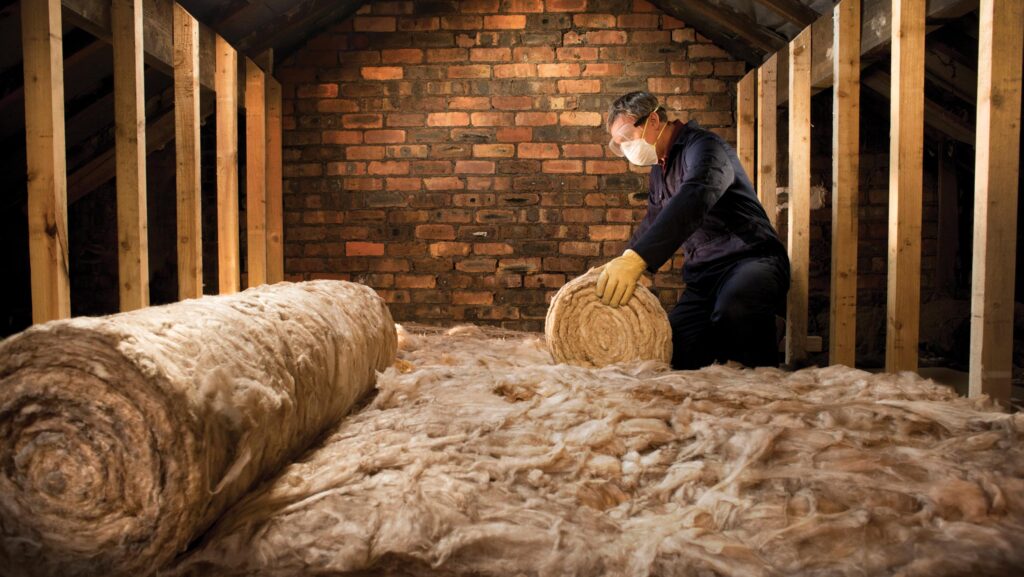
© iStockphoto
The Energy Saving Trust estimates that internal solid wall insulation for a semi-detached house costs £8,200 to install, but could save £255 a year on energy bills. Installing internal wall insulation can be very disruptive, though, so may incur additional costs.
External insulation is less intrusive, but may not be allowed on listed buildings. Also, installation requires care around features such as windows, guttering and roof overhangs.
Where possible, cavity wall insulation can be quick, relatively cheap and effective, but Michael Fountain advises to always use an approved installer – the Cavity Insulation Guarantee Agency (CIGA) provides an independent 25-year guarantee for cavity wall insulation fitted by a registered installer.
He also notes that building regulations prohibit its use in exposed properties at risk of wind-driven rain, which increases the risk of damp penetrating through to the inside.
Stop draughts
Historic England estimates that older buildings can lose 15-20% of heat via draughts.
There are many simple, relatively low-cost ways to address this, such as fitting seals/brushes around windows or doors, blocking disused chimneys (while maintaining ventilation to prevent damp), and sealing around pipework, floorboards, letterboxes, loft hatches, light fittings, redundant extractor outlets, etc.
Remember, though, before blocking every gap ensure adequate ventilation is maintained to prevent damp and condensation forming.
Do not seal or block working extractor fans, underfloor grilles or airbricks, wall vents, or trickle vents on windows.
Improve windows
Windows can be a major source of heat loss, so consider installing more energy efficient windows or secondary double glazing (for example in a listed property). Improving windows can also make a big difference to occupier comfort.
A cheaper alternative may be to use heavy curtains, blinds or shutters.
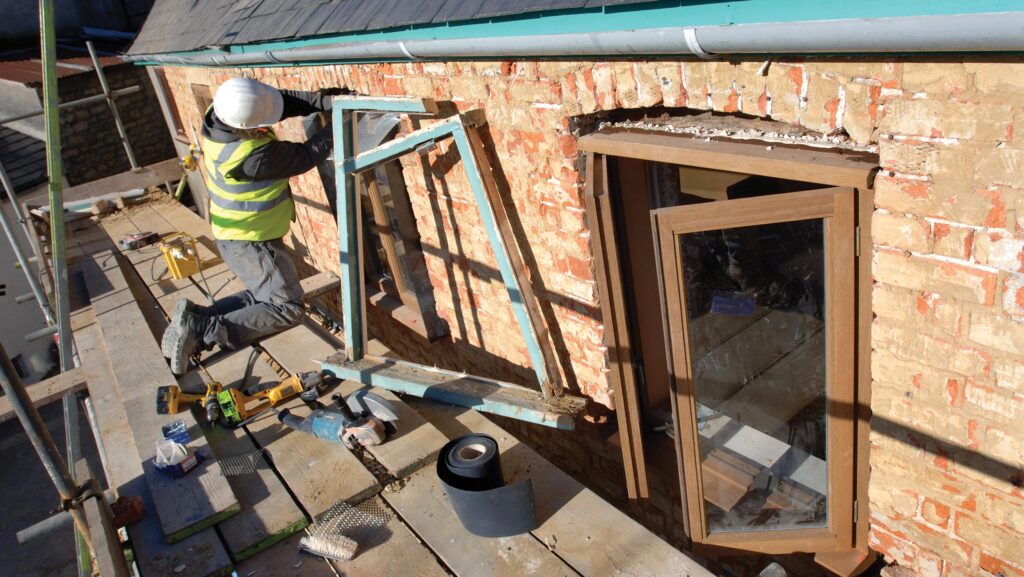
© Adrian Sherrat/Alamy Stock Photo
Upgrade heating controls
More accurate control of heating for individual rooms or parts of the house is an easy, low-intrusion and effective way to improve energy efficiency.
This might include fitting standard radiator valves, or “smart” alternatives to allow digital control of different heating zones within the property. Equipment costs are relatively low, but factor in labour charges for a plumber to install equipment.
Fitting a weather compensation sensor to compatible boilers can also improve their efficiency, by automatically regulating boiler output according to ambient external temperatures and the desired internal room temperature.
Summary options for three example properties |
|||
|
|
Small bungalow |
Semi-detached cottage |
Farmhouse |
|
Age |
1960s |
Early 1900s |
Period property |
|
Approx size (sq m) |
60 |
120 |
250 |
|
Construction |
Standard solid brick wall, possibly with a basic cavity wall |
Standard brick, solid wall or basic cavity wall. Suspended timber floors with air vents |
Brick or stone with no cavity wall |
|
Current heating and hot water |
LPG and traditional radiators, plus a small 5kW wood burner for secondary heating |
Oil-fired boiler, plus a 5kW wood burner |
Oil-fired boiler for central heating and hot water, plus a 15kW wood burner |
|
Likely EPC rating |
D/E |
E/F |
E/F |
|
Energy efficiency improvements |
|
As for bungalow, plus:
|
As for bungalow & cottage, plus:
|
|
Alternative heating/hot water options |
|
As for bungalow, plus:
|
|
There is a range of financial support available for various energy efficiency measures.
Some is targeted at lower income households, or those with poorer EPC ratings in certain postcode areas, while other schemes may be open to all.
Below is a summary of the main options, but always check details carefully with the provider to see if you are eligible.
Support available |
|||||
|
Scheme name |
What is it for? |
Is it income based? |
How much is available? |
How do I apply? |
What’s the catch? |
|
Energy Company Obligation (ECO) – ECO4 is the fourth generation of the scheme, scheduled to run until 2026 |
Grants for various energy efficiency measures, such as boilers, insulation (cavity wall/lofts), replacement of old electric heaters with energy efficient storage heaters, heating controls, solar panels |
Yes. Aimed at homeowners or tenants on low incomes (less than £31k annual household income). Landlords can apply if tenant income is below the threshold |
Up to 100% of costs, subject to circumstances |
Via energy supplier. Most energy companies belong to the ECO (biggest firms have to sign up), so check eligibility with your supplier |
Various conditions apply, for example EPC rating D or below, and someone in the house must be on certain benefits, such as pension credit, universal credit, child benefit, income support and housing benefit. Applicants are assessed to determine eligibility and the most suitable options |
|
Great British Insulation Scheme |
Government scheme offering various types of free loft, wall, roof and floor insulation |
No. Support is available for both low-income groups and for others where EPC rating is D to G and in certain council tax bands |
Up to 100% of costs, depending on circumstances |
Directly to GBIS: gov.uk/apply-great-british-insulation-scheme |
Open to people who own or rent their own home, but property must be in council tax bands A to D in England, A to E in Scotland and Wales, and have EPC rating of D or below. Eligibility is subject to property assessment |
|
Home Upgrade Grant (England) |
Money towards energy efficiency measures, such as wall, loft and underfloor insulation, heat pumps, solar panels, double glazing, low-energy lighting and electric storage heaters |
Yes |
Up to 100% of costs, subject to eligibility |
Via local council |
Aimed at those living off the main gas grid, on low income and with an EPC rating from D to G. Only available in certain postcode areas |
|
Warm Homes Nest scheme (Wales only) Existing scheme is closed to new applicants, but is due to be relaunched on 1 April 2024 |
Free energy efficiency home improvements (new boiler, radiators, heating controls and insulation) |
Yes |
Varies depending on circumstances |
Via the Welsh Government nest.gov.wales/ |
Aimed at those receiving certain benefits and suffering from a chronic respiratory, circulatory or mental health condition |
|
Warmer Homes Scotland |
Free energy efficiency installations (similar to those above) |
Yes |
Up to 100% of costs. Customer contribution may be required – interest-free loan available |
Via the Warmer Homes Scotland self-assessment form: homeenergyscotland-advice.est.org.uk/selfassessment/ |
Must have lived in the property for at least 12 months and be on certain benefits |
|
Boiler Upgrade Scheme |
Covers part of the cost of replacing fossil fuel heating systems with a heat pump or biomass boiler |
No |
Up to £7,500 towards an air- or ground-source heat pump, or £5,000 towards a biomass boiler |
Via an MCS certified installer – they apply to Ofgem on your behalf if eligible |
Only available on systems up to 45kWh and for properties with a valid EPC with no outstanding recommendations for loft or cavity wall insulation |
EPC dilemma
Both advisers point out that the domestic EPC system was initially introduced to tackle fuel poverty, so ratings are heavily influenced by the cost of the fuel used, rather than carbon emissions.
Currently, on a cost per kilowatt basis, gas is cheapest, followed by oil, LPG and electric.
This potentially means a property owner could invest in new low-carbon, electric technology (such as an air-source heat pump and electric radiators) to replace an oil-fired central heating system, only to find the EPC rating falls but the property has low carbon emissions.
This is a particularly important consideration for landlords trying to comply with minimum EPC standards, although it is possible to apply for an exemption.
Commercial EPCs are based on carbon emissions, as are building regulations for new builds, so it is thought that domestic EPCs may follow suit at some point, although there are no plans for reform at this stage.
